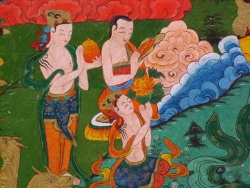Difference between revisions of "Buddhist Logic and Ontology. A Survey of Contemporary Studies"
| Line 1: | Line 1: | ||
{{DisplayImages|1442|459|77}} | {{DisplayImages|1442|459|77}} | ||
<poem> | <poem> | ||
| − | "In the non-Buddhist [[traditions]] of [[Indian]] [[philosophical]] [[thought]], and perhaps also in early [[Buddhist]] [[thought]], there appears to be a tacit [[acceptance]] of the possibility of acquiring [[knowledge]] of [[reality]]. However, [[Nâgârjuna]] (about AD 250), a later [[Buddhist]] [[dialectical]] thinker, raised serious [[doubts]] about the possibility of acquiring [[knowledge]] by pointing out the self-contradictory [[character]] of all means of acquiring [[knowledge]], [[Nâgârjuna's]] objections stimulated and compelled all subsequent [[philosophers]] provide a solid foundation to {{Wiki|epistemology}} and [[logic]] before proceeding with the formulations of their [[philosophical]] positions. | + | "In the [[non-Buddhist]] [[traditions]] of [[Indian]] [[philosophical]] [[thought]], and perhaps also in early [[Buddhist]] [[thought]], there appears to be a tacit [[acceptance]] of the possibility of acquiring [[knowledge]] of [[reality]]. However, [[Nâgârjuna]] (about AD 250), a later [[Buddhist]] [[dialectical]] thinker, raised serious [[doubts]] about the possibility of acquiring [[knowledge]] by pointing out the self-contradictory [[character]] of all means of acquiring [[knowledge]], [[Nâgârjuna's]] objections stimulated and compelled all subsequent [[philosophers]] provide a solid foundation to {{Wiki|epistemology}} and [[logic]] before proceeding with the formulations of their [[philosophical]] positions. |
| − | In [[Buddhist]] circles [[Asanga]] (about AD 405) and [[Vasubandhu]] (about AD 410) made pioneering attempts to construct {{Wiki|epistemology}} and [[logic]] on the [[Buddhist]] pattern. However it was [[Dignâga]] (about AD 450) who put [[Buddhist]] {{Wiki|epistemology}} and [[logic]] on a solid footing and gave them a {{Wiki|distinctive}} [[character]]. He is, therefore, rightly regarded as the father of [[Buddhist]] {{Wiki|epistemology}} and [[logic]], and also of {{Wiki|medieval}} [[Indian]] {{Wiki|epistemology}} and [[logic]] in general, for he not only gave a precise formulation to [[Buddhist]] {{Wiki|epistemology}} and [[logic]] but also imparted a new [[direction]] to [[Indian]] {{Wiki|epistemology}} and [[logic]] by way of composing independent treatises on {{Wiki|epistemology}} and [[logic]] and interspersing the treatment of [[metaphysical]] problems within them, a style which was later on followed by [[Gangesa]] (about the twelfth century AD), the founder of the school of [[Navya-Nyaya]]. [[Buddhist]] {{Wiki|literature}} prior to [[Dignaga]] deals with the problem of [[knowledge]] and the means of [[knowing]] either very casually or not at all. There seems to be no work devoted to the problem. But [[Dignaga]] felt the necessity for a {{Wiki|distinct}} treatise on {{Wiki|epistemology}} and [[logic]] to establish the [[Buddhist]] [[doctrines]] in a [[logical]] [[manner]]. He explicitly mentions in the [[Pramâna-samuccaya]] that its composition was led by the need to establish the means of [[valid cognition]]. | + | In [[Buddhist]] circles [[Asanga]] (about AD 405) and [[Vasubandhu]] (about AD 410) made pioneering attempts [[to construct]] {{Wiki|epistemology}} and [[logic]] on the [[Buddhist]] pattern. However it was [[Dignâga]] (about AD 450) who put [[Buddhist]] {{Wiki|epistemology}} and [[logic]] on a solid footing and gave them a {{Wiki|distinctive}} [[character]]. He is, therefore, rightly regarded as the father of [[Buddhist]] {{Wiki|epistemology}} and [[logic]], and also of {{Wiki|medieval}} [[Indian]] {{Wiki|epistemology}} and [[logic]] in general, for he not only gave a precise formulation to [[Buddhist]] {{Wiki|epistemology}} and [[logic]] but also imparted a new [[direction]] to [[Indian]] {{Wiki|epistemology}} and [[logic]] by way of composing {{Wiki|independent}} treatises on {{Wiki|epistemology}} and [[logic]] and interspersing the treatment of [[metaphysical]] problems within them, a style which was later on followed by [[Gangesa]] (about the twelfth century AD), the founder of the school of [[Navya-Nyaya]]. [[Buddhist]] {{Wiki|literature}} prior to [[Dignaga]] deals with the problem of [[knowledge]] and the means of [[knowing]] either very casually or not at all. There seems to be no work devoted to the problem. But [[Dignaga]] felt the necessity for a {{Wiki|distinct}} treatise on {{Wiki|epistemology}} and [[logic]] to establish the [[Buddhist]] [[doctrines]] in a [[logical]] [[manner]]. He explicitly mentions in the [[Pramâna-samuccaya]] that its composition was led by the need to establish the means of [[valid cognition]]. |
| − | The task initiated by [[Dignaga]] was brilliantly continued by [[Dharmakirti]] (about 635), a doyen of [[Buddhist]] {{Wiki|epistemology}} and [[logic]]. His [[Pramâna-vârtika]], [[Pramânaviniscaya]] and [[Nyaya-bindu]] are masterpieces of [[Buddhist]] {{Wiki|epistemology}} and [[logic]]. When [[Dignaga]] undertook an examination of the [[logical]] {{Wiki|tenets}} of other [[philosophical]] schools in his treatise there were reactions from the latter. For instance, [[Uddyotakara]] and Kumarila (about AD 500) tried to controvert the [[views]] of [[Dignaga]]. [[Dharmakirti]] therefore defended and modified the [[views]] of [[Dignaga]], thereby strengthening the foundations of [[Buddhist]] {{Wiki|epistemology}} and [[logic]]. However, his [[exposition]], which was ended to explain and defend the [[views]] of [[Dignaga]], superseded and eclipsed the original by its {{Wiki|superior}} [[merit]]. This [[tradition]] of [[Dharmakirti]] was carried forward by [[Darmottara]] (about AD 847) and subsequently by, amongst others, [[Jnanasrimitra]] about AD 1040)." | + | The task [[initiated]] by [[Dignaga]] was brilliantly continued by [[Dharmakirti]] (about 635), a doyen of [[Buddhist]] {{Wiki|epistemology}} and [[logic]]. His [[Pramâna-vârtika]], [[Pramânaviniscaya]] and [[Nyaya-bindu]] are masterpieces of [[Buddhist]] {{Wiki|epistemology}} and [[logic]]. When [[Dignaga]] undertook an {{Wiki|examination}} of the [[logical]] {{Wiki|tenets}} of other [[philosophical]] schools in his treatise there were reactions from the [[latter]]. For instance, [[Uddyotakara]] and [[Wikipedia:Kumārila Bhaṭṭa|Kumarila]] (about AD 500) tried to controvert the [[views]] of [[Dignaga]]. [[Dharmakirti]] therefore defended and modified the [[views]] of [[Dignaga]], thereby strengthening the foundations of [[Buddhist]] {{Wiki|epistemology}} and [[logic]]. However, his [[exposition]], which was ended to explain and defend the [[views]] of [[Dignaga]], superseded and eclipsed the original by its {{Wiki|superior}} [[merit]]. This [[tradition]] of [[Dharmakirti]] was carried forward by [[Darmottara]] (about AD 847) and subsequently by, amongst others, [[Jnanasrimitra]] about AD 1040)." |
From: S. R. [[Bhatt]] - [[Logic]] and [[language]] in [[Buddhism]] in: Brian Carr, Indira Mahalingam (eds.) - Companion {{Wiki|Encyclopedia}} of {{Wiki|Asian}} [[philosophy]] - {{Wiki|London}}, Routledge, 1997, pp. 414-415. | From: S. R. [[Bhatt]] - [[Logic]] and [[language]] in [[Buddhism]] in: Brian Carr, Indira Mahalingam (eds.) - Companion {{Wiki|Encyclopedia}} of {{Wiki|Asian}} [[philosophy]] - {{Wiki|London}}, Routledge, 1997, pp. 414-415. | ||
Latest revision as of 04:53, 7 February 2015
"In the non-Buddhist traditions of Indian philosophical thought, and perhaps also in early Buddhist thought, there appears to be a tacit acceptance of the possibility of acquiring knowledge of reality. However, Nâgârjuna (about AD 250), a later Buddhist dialectical thinker, raised serious doubts about the possibility of acquiring knowledge by pointing out the self-contradictory character of all means of acquiring knowledge, Nâgârjuna's objections stimulated and compelled all subsequent philosophers provide a solid foundation to epistemology and logic before proceeding with the formulations of their philosophical positions.
In Buddhist circles Asanga (about AD 405) and Vasubandhu (about AD 410) made pioneering attempts to construct epistemology and logic on the Buddhist pattern. However it was Dignâga (about AD 450) who put Buddhist epistemology and logic on a solid footing and gave them a distinctive character. He is, therefore, rightly regarded as the father of Buddhist epistemology and logic, and also of medieval Indian epistemology and logic in general, for he not only gave a precise formulation to Buddhist epistemology and logic but also imparted a new direction to Indian epistemology and logic by way of composing independent treatises on epistemology and logic and interspersing the treatment of metaphysical problems within them, a style which was later on followed by Gangesa (about the twelfth century AD), the founder of the school of Navya-Nyaya. Buddhist literature prior to Dignaga deals with the problem of knowledge and the means of knowing either very casually or not at all. There seems to be no work devoted to the problem. But Dignaga felt the necessity for a distinct treatise on epistemology and logic to establish the Buddhist doctrines in a logical manner. He explicitly mentions in the Pramâna-samuccaya that its composition was led by the need to establish the means of valid cognition.
The task initiated by Dignaga was brilliantly continued by Dharmakirti (about 635), a doyen of Buddhist epistemology and logic. His Pramâna-vârtika, Pramânaviniscaya and Nyaya-bindu are masterpieces of Buddhist epistemology and logic. When Dignaga undertook an examination of the logical tenets of other philosophical schools in his treatise there were reactions from the latter. For instance, Uddyotakara and Kumarila (about AD 500) tried to controvert the views of Dignaga. Dharmakirti therefore defended and modified the views of Dignaga, thereby strengthening the foundations of Buddhist epistemology and logic. However, his exposition, which was ended to explain and defend the views of Dignaga, superseded and eclipsed the original by its superior merit. This tradition of Dharmakirti was carried forward by Darmottara (about AD 847) and subsequently by, amongst others, Jnanasrimitra about AD 1040)."
From: S. R. Bhatt - Logic and language in Buddhism in: Brian Carr, Indira Mahalingam (eds.) - Companion Encyclopedia of Asian philosophy - London, Routledge, 1997, pp. 414-415.
"(...) from the origin of Buddhism in the 6th century b.C. to its expansion into four philosophical schools in the 4th century A.D., there were no systematic Buddhist works on Logic, but only a few stray references to that science in the works on philosophy and religion. Nagàrjuna, about 300 A.D., wrote a tract on Logic which was a mere review of the common topics of the Ancient School of Brahmanic Logic. During 400-500 A.D., Maitreya, Asanga and Vasubandhu handled Logic, but their treatment of it was merely incidental, being mixed up with the problems of the Yogacara and Vaibhasika schools of philosophy. Vasubandhu's three works on Pure Logic mentioned by Hwen-thsang are now lost and consequently their merits cannot be judged. With 450 A.D. began a period when Logic was completely differentiated from general philosophy, and a large number of Buddhist writers gave their undivided attention to that branch of learning. The works brought out by these. writers, along with those brought out by the Jainas, constitute the Mediaeval School of Indian Logic. Dignaga is the earliest known writer of this school."
From: Satis Chandra Vidyabhusana - A history of Indian logic. Ancient, Mediaeval and Modern Schools - (1920) Reprinted by Motilal Barnasidass, Delhi, 2002 p. 270.


